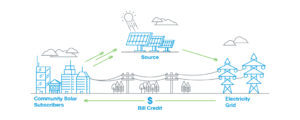In order to participate in community solar, your state needs to have a program in place that allows “virtual net metering”. Virtual net metering provides a business with credits on its utility bill for the grid-connected solar it receives through a community solar project. Fortunately, community solar projects are located in the majority of U.S. states.
If you are considering community solar for your business, it’s important to make sure that your utility bill is large enough to offset the credits you may receive by participating. The credits can only be applied to your utility bill, not a separate supplier bill. Companies can consider consolidating the supplier charges on their utility bill, but it’s important to note that not all suppliers and utilities will provide consolidated billing. Check with your Premier Power Solutions energy consultant to help better understand any billing implications you may have. State rules may allow credits to be re-allocated among multiple sites in the same electric utility load zones.
In cases where you are looking to claim the value of the environmental attributes of community solar, it is important to understand where the actual environmental value is going. For example, in New York, the official environmental value of community solar goes to the utility. The utility is using the environmental attributes to meet its renewable standards on its system. Because of this, you will not be able to claim the environmental attribute, but rather only receive the energy credit on the bill. If part of your goal is to be able to make the environmental claim, you may want to consider Renewable Energy Credits (RECs).




